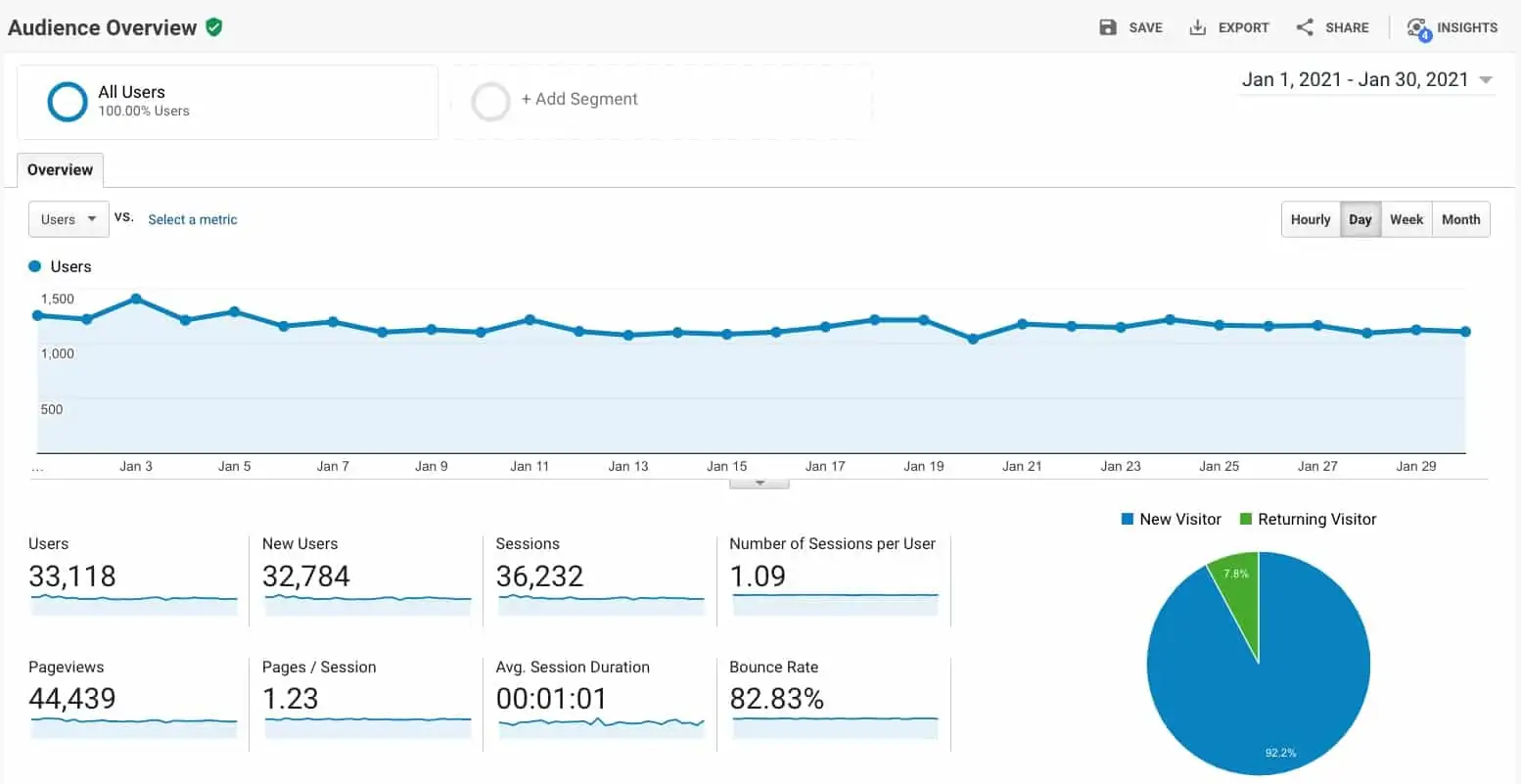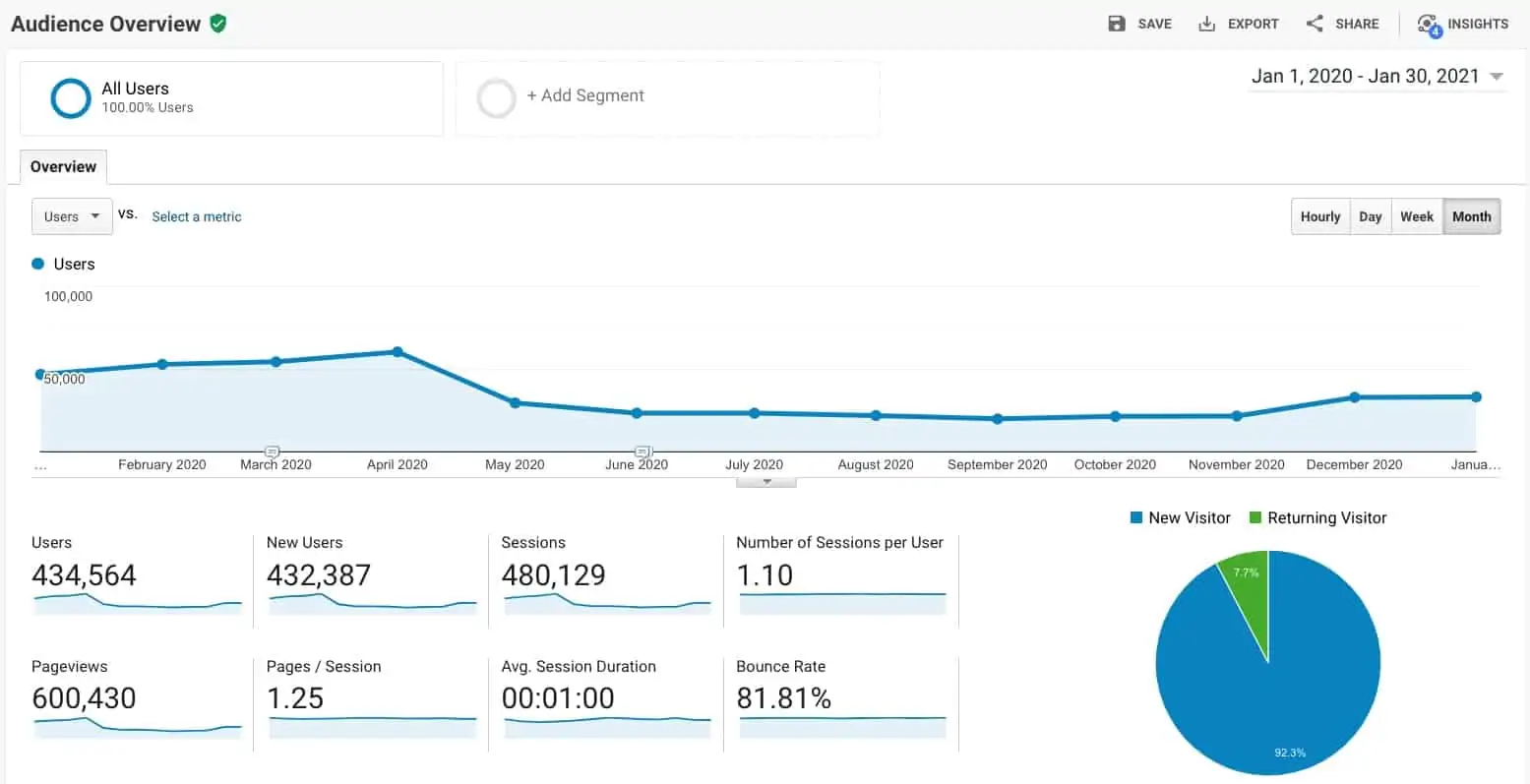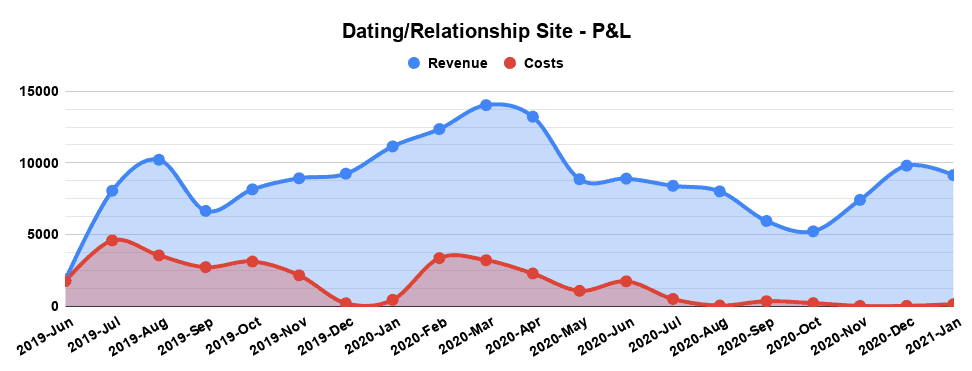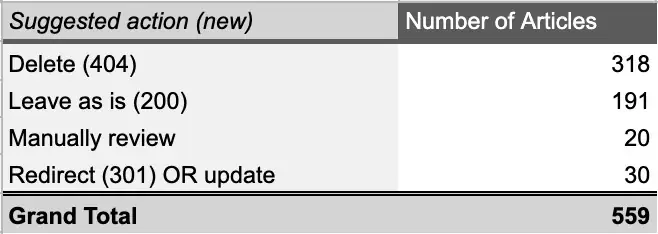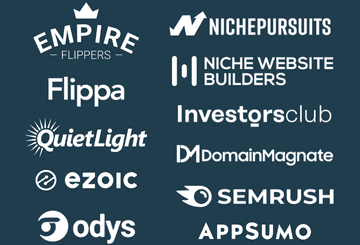This is the January 2021 update. The revenue is at $9,147 vs $9,810 in December 2020. The website is doing well and traffic remains steady.
I cover the following in this month’s case study update:
- Traffic and revenue update
- Spotting Tier 2 PBN links
- Content audit tactics
- Increase in commission payments
- Planned Improvements for February
For the previous update in December, check out this post, or check out all the posts here.
📊 January 2021 Traffic and Income Stats
📉 Pageviews
- August 2020 Pageviews: 31,084
- September 2020 Pageviews: 27,032
- October 2020 Pageviews: 29,306
- November 2020 Pageviews: 30,016
- December 2020 Pageviews: 44,182
- January 2021 Pageviews: 44,439
January 2021 Traffic Breakdown:
Traffic Breakdown (L12M):
💰 Revenue
The site’s traffic remained relatively the same from January to December (44,182 vs 44,439 pageviews), however, the earnings decreased from $9,810 and $9,147. This could be related to the January “slump” of earnings that most experience.
Last 12-mo P&L
January 2021: Improvements To The Site
Commissions Payments Increased!
Every 6 months I do a high-level data-driven audit look into my revenues, traffic, and commission structures. If I see that I am driving more traffic, or placing the affiliate brand in more locations, I ask for a commission increase.
I found two of my networks that I was driving more traffic to. Their structures were as follows:
- Primary affiliate: generating $5,000/mo average at $57 CPA
- Secondary affiliate: generating $2,000/mo average at $80 CPA
I emailed them the following:
After a bit of back and forth, the networks obliged and increased rates as follows:
- Primary affiliate: $57 CPA to $60 CPA. Increase of $150/mo average.
- Secondary affiliate: $80 CPA to $85 CPA. Increase of $200/mo average
With absolutely no changes to the website, I was able to increase total revenues by $350/mo with a few emails. This equates to about $10,500 (30x multiple) in valuation when selling. Easy win!
Content Audit -> Delete 279 Articles!?
I did a content audit on this site using AHREFs template found here. The template has you pull in data from AHREFs, Google Analytics, and your sitemap of URLs. You then enter conditions as follows:
Based on the conditions, there will be 4 actions that will be highlighted for each URL. They are:
- Delete (404) – Has no meaningful traffic and no backlinks.
- Redirect (301) or update – Has no meaningful traffic yet meets the minimum backlinks threshold.
- Leave as is (200) – Has meaningful traffic, a good amount of which is derived from organic search.
- Manually review– Has meaningful traffic, little to none of which is derived from organic search. See the blog post or video to learn how to deal with this.
After running the results, the content audit showed that I should do the following actions:
The tool is saying to delete 318 out of 559 articles on my website because it has traffic of fewer than 365 visitors annually, and no backlinks. I definitely will not be deleting that much content!
A tool is a tool; you and I can use it to get more data but do not blindly do exactly what it says. A content audit also requires manual review to check if the articles should be kept or not.
Here are a few reasons why you should keep content even though tools may tell you to delete:
- Topical relevancy: some content will never get traffic; they are there to show you are a topical expert so your other content ranks better
- Published/modified recently: if you published just recently (less than 2 months ago), it definitely will not see traffic. Keep the content on the site to let it settle in the search engines
- High conversion rates: Some content converts better than others. With minimal traffic, you may have high conversions. Before deleting, understand the commercial intent of the content and whether it generates sales.
With that said, I did the following:
- Deleted (404 not found page): 27 articles
- Rewrite content: 10 articles
The 10 articles that I flagged to be written were good keywords but the content was poor quality. I’ve outsourced that to a better writer to have it rewritten.
Industry Trends Report for 2020
This website has been around since 2004 with quality backlinks from CNN, Forbes, NY Times, US government, among others. I wanted to leverage this and had our writer write an Industry Trends Report.
This report is a data-driven, case study article about the entire sub-industry this site is in. Within the article the following was featured:
- Statistics from news articles
- Charts/tables from news articles
- Our findings over the course of 1-year in terms of industry changes
- Technology and market changes
The idea is to launch an outreach campaign pitching this article as the go-to industry recap for 2020. The goal is to pick up backlinks to this article which would then internally link to articles on the site.
10 Articles Pending
From the content audit, I found 10 articles that need to be rewritten. To ensure quality, the writer will be actually using the service and doing a hands-on review with screenshots.
This is one way to build a moat around your business: do the things that other affiliate sites don’t do. Actually purchase the product/service, try it out, take screenshots, and explain the step-by-step process. Your content will be that much better.
My process for figuring out which articles require a hands-on review is as follows:
- Publish a non-hands-on review article with proper on-page SEO first
- Analyze with time if it starts to get rankings and traffic
- Rewrite the same article with hands-on reviews, screenshots, etc after it starts to get traction
Make sure when rewriting that you do not change the URL structure. Keep that the same. The reason to wait is to see which keywords get traction, and then double down and invest further. Don’t waste money early on.
Accepting Guest Posts Led to Tier 2 PBN links!
After looking through the newly obtained backlinks to different pages on my site, I saw one page that received 54 backlinks from 31 referring domains. That’s out of the ordinary! The article was a guest post I accepted.
Note that I do not usually accept guest posts on my sites unless the payment is justified. Most guest posters are just looking for a backlink. I accepted this guest post because they were willing to pay $500 for it. I cannot say no to that.
All of the backlinks built to the article on my site were low-quality Tier 2 links from a Private Blog Network (PBNs). Graphically, a typical guest post looks like this:
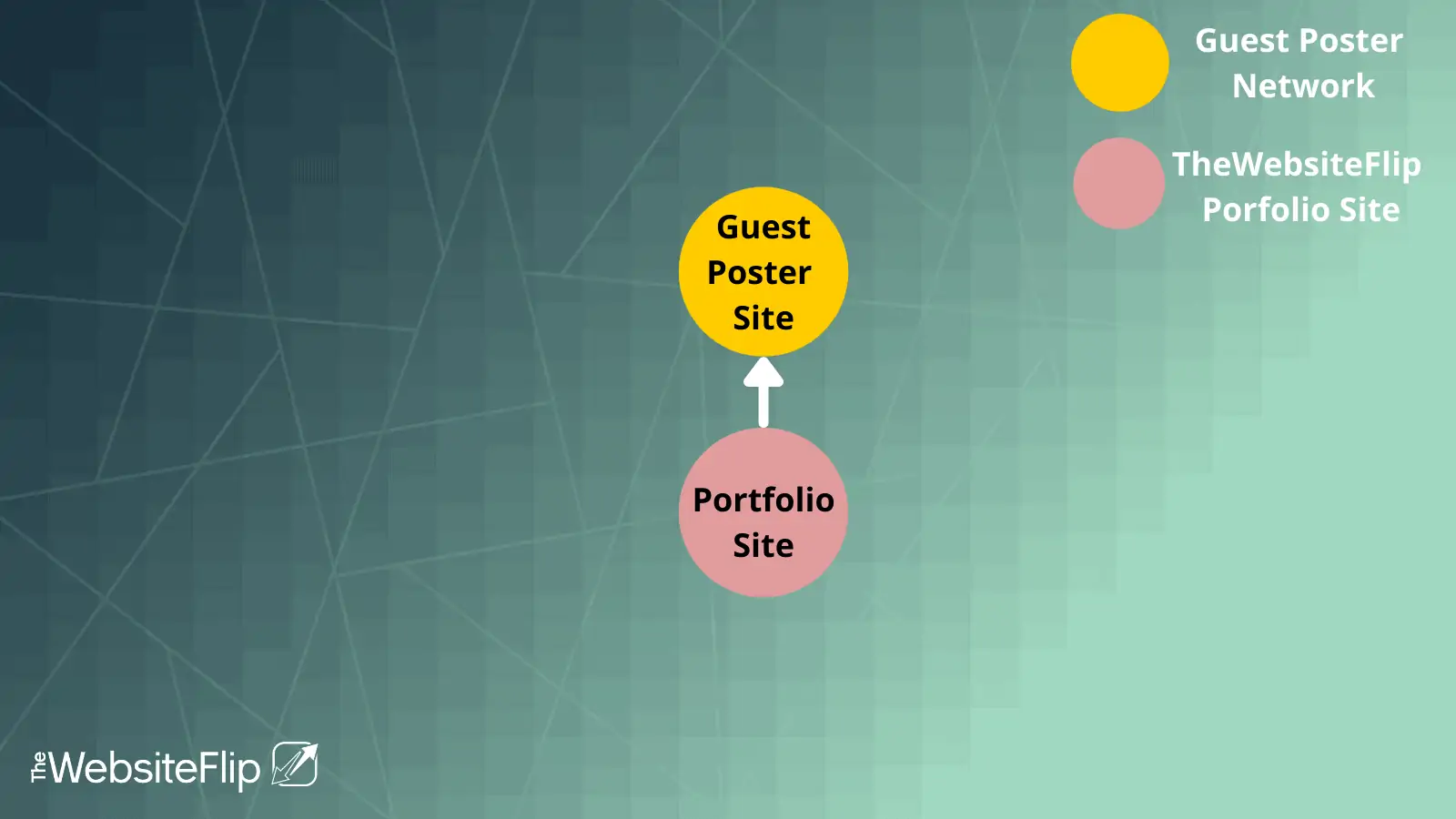
This is usually not a problem; you pass portion of you link authority over to the guest poster’s site. However, this is what was happening:
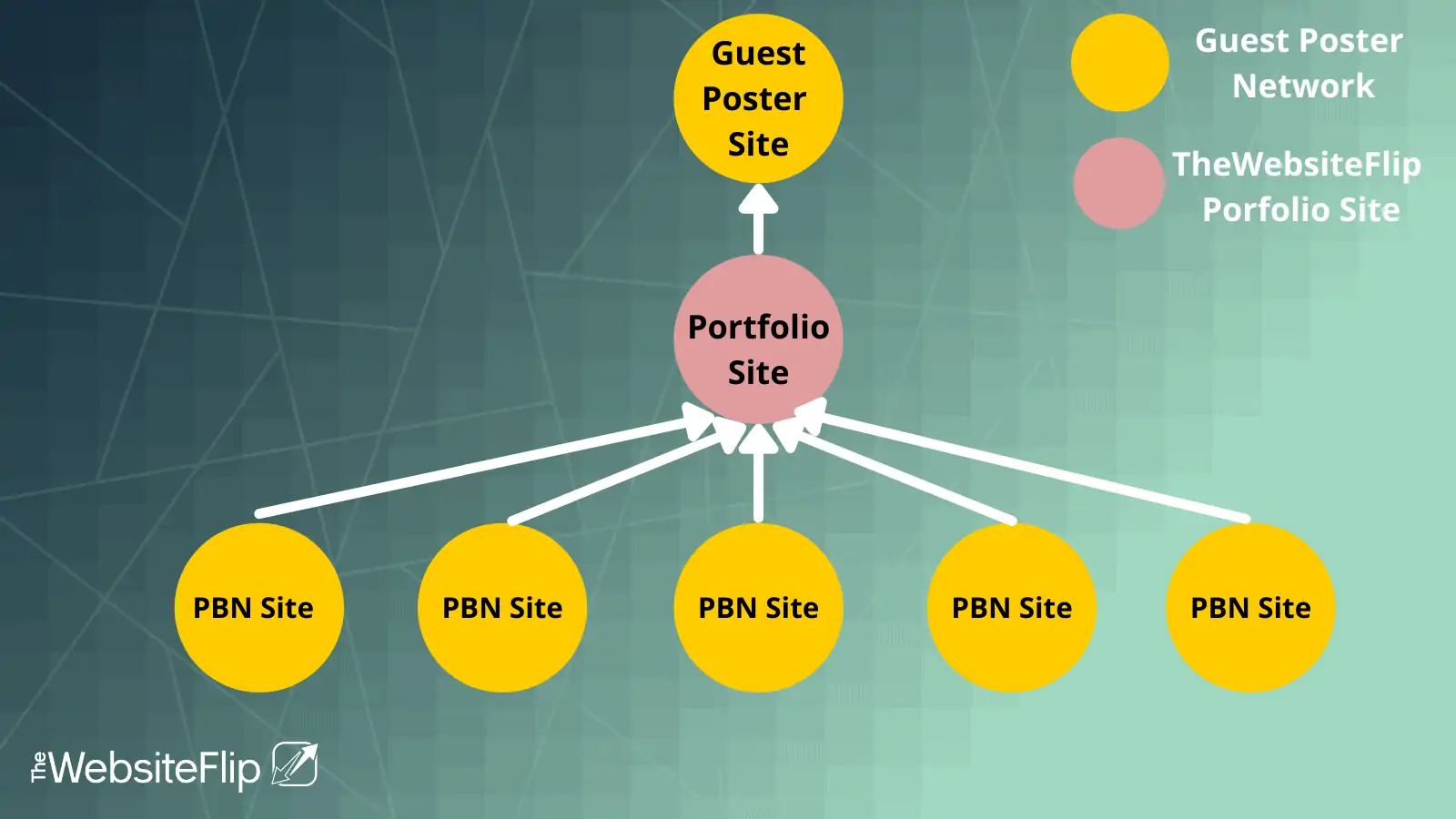
The guest poster was using their PBNs as a tier 2 network to build links to my website’s article. This increases the authority of my page thus subsequently their pages on their main site.
My course of action was as follows:
- Download the list of referring domains pointing to this page
- Add the domains to the disavow file in Google Search Console
- Delete the article from the site completely
- Side action: never accept any more guest posts
What to improve in February 2021?
Here’s the plan:
- Update old content: Many of the articles have not been updated since 2019. The goal is to update a batch of articles each week over the course of February.
- Publish new content
- Interlink content: use Link Whisper and interlink relevant pages together
Recommendation: Do a Backlink Audit!
That’s it for this update. I highly recommend every site owner do a backlink audit. Use AHREFs or Google Search Console and manually review all of your links. If they do not seem normal, it’s in your best interest to disavow them.
While this is not an “easy win” that will immediately increase traffic/revenues, it will keep the foundation of your website strong.

